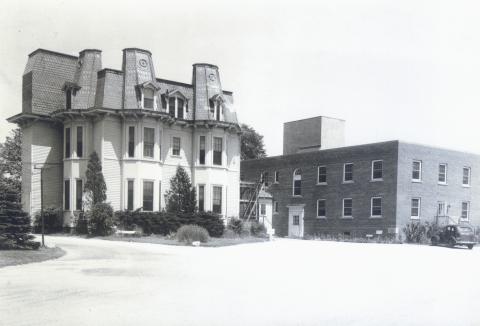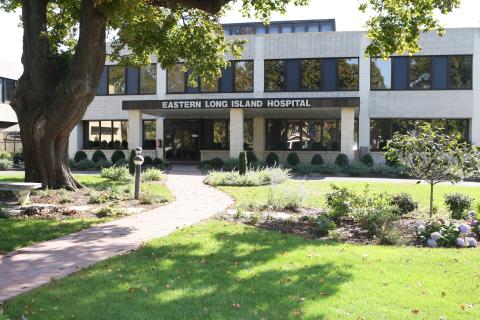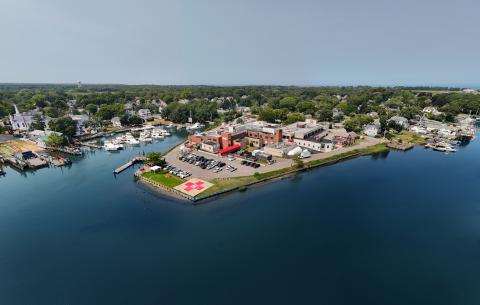
Stony Brook Eastern Long Island Hospital (SBELIH), originally known as Eastern Long Island Hospital (ELIH), recently celebrated 120 years of continuous service to the residents of the North Fork and Shelter Island. Established in 1905, it was Suffolk County’s first voluntary hospital. The hospital’s roots trace back to a Victorian mansion donated by the Wood Sisters, which served as the hospital’s original home. Through the efforts of the newly formed Eastern Long Island Hospital Association and the Ladies’ Auxiliary, the mansion was transformed into a facility for patient care. By 1916, funds raised by the Auxiliary helped install a steam heating system and an x-ray machine. The only remaining structure from the original estate, The Red House, later served a variety of functions, including housing the Opportunity Shop, Laundry, and Community Relations Office.
Throughout the decades, the hospital expanded to meet the growing healthcare needs of the community. The 1920s saw the addition of a motor ambulance and modern sewage system, while the 1930s brought a delivery room and a children’s ward. A fireproof brick wing was constructed in 1939. Enhancements during the 1940s, 50s, and 60s were largely supported by the “Victory Fund Drive,” honoring those who served in World War II. In the 1970s, new operating suites, an ICU-CCU, a helipad, and updated ambulatory care and lab facilities were added. The 1980s saw the introduction of ultrasound imaging, a mental health unit, and an alcohol rehabilitation center. From the 1990s forward, the hospital rapidly evolved into a modern facility offering state-of-the-art care while preserving its community roots.
 The 2000s marked a decade of significant growth and technological advancement for the hospital. In 2001, the Gladys Brooks Ambulatory Surgery Pavilion opened, followed by the debut of a modern Emergency Department in 2004. The establishment of the Eastern Long Island Hospital Foundation in 2006 created a formal structure for philanthropic support, and in 2008, the hospital expanded its services further with the opening of the new Diagnostic Imaging Center. The hospital chapel was dedicated in 2011, offering a quiet space for reflection and spiritual support.
The 2000s marked a decade of significant growth and technological advancement for the hospital. In 2001, the Gladys Brooks Ambulatory Surgery Pavilion opened, followed by the debut of a modern Emergency Department in 2004. The establishment of the Eastern Long Island Hospital Foundation in 2006 created a formal structure for philanthropic support, and in 2008, the hospital expanded its services further with the opening of the new Diagnostic Imaging Center. The hospital chapel was dedicated in 2011, offering a quiet space for reflection and spiritual support.
In 2013, the hospital acquired a state-of-the-art 128 Multi-Slice CT scanner from Siemens Medical Solutions, significantly enhancing diagnostic capabilities. Diagnostic imaging expanded again in 2016 with the addition of 3D Mammography/Tomosynthesis, offering advanced breast imaging technology. That same year, the Storm Hardening Project, generously funded by the David J. and Bobbie Marks Family Fund and Peter and Erica Harold, was completed, reinforcing the hospital’s infrastructure. In 2017, surgical precision was elevated with the installation of a high-resolution Olympic 4K surgical camera system, which allowed for less invasive procedures and improved outcomes for patients.
 In 2019, ELIH officially joined the Stony Brook Medicine network and became SBELIH. The years that followed saw significant advancements. In 2020, the hospital invested in updated equipment including LUCAS II cardiac devices, Stryker LIFEPAK 15 defibrillators, a Cepheid GeneXpert 4 for COVID-19 testing, a portable UV cleaning robot, and more. Quannacut Outpatient Services expanded into Southampton, and telepractice addiction services received a grant from New York State. In 2021, SBELIH collaborated with the Greenport Village BID, Greenport Harbor Brewing Co., and Community Action for Social Justice to launch the Narcan Rescue Station program. New MRI and ultrasound equipment was installed, along with patient monitoring technology. In 2022, the hospital marked the graduation of its first Psychiatry resident, established a Nursing Education Fund and Physician Retention Fund, and was designated an LGBTQ+ Healthcare Equality Leader.
In 2019, ELIH officially joined the Stony Brook Medicine network and became SBELIH. The years that followed saw significant advancements. In 2020, the hospital invested in updated equipment including LUCAS II cardiac devices, Stryker LIFEPAK 15 defibrillators, a Cepheid GeneXpert 4 for COVID-19 testing, a portable UV cleaning robot, and more. Quannacut Outpatient Services expanded into Southampton, and telepractice addiction services received a grant from New York State. In 2021, SBELIH collaborated with the Greenport Village BID, Greenport Harbor Brewing Co., and Community Action for Social Justice to launch the Narcan Rescue Station program. New MRI and ultrasound equipment was installed, along with patient monitoring technology. In 2022, the hospital marked the graduation of its first Psychiatry resident, established a Nursing Education Fund and Physician Retention Fund, and was designated an LGBTQ+ Healthcare Equality Leader.
The hospital continued to modernize in 2023 with the addition of a new radiology suite featuring advanced technology and the installation of an Abbott Architect 16200 Chemistry Analyzer in the lab. The hospital also acquired a Vapotherm High Velocity Therapy 2.0 device. That year, SBELIH and C.A.S.T. launched the Food as Medicine program to help patients facing food insecurity, and a Suffolk County Opioid Settlement Grant helped advance the Quannacut Recovery Home Expansion Program. In 2024, SBELIH partnered with Food Rescue US North Fork, completed and dedicated the Emergency Department Ambulance Dock modification, and opened the Harold Family Clinical Laboratory to support enhanced lab services. The hospital expanded its recovery services by adding two new Recovery Homes for women and LGBTQ+ individuals and dedicated the renovated Brennan Family Foundation Emergency Department Nurses Station.

SBELIH is currently working toward achieving Primary Stroke Center designation in 2025, a milestone that will bring advanced, life-saving neurological care to the East End. The ELIH Foundation launched a major fundraising campaign to support this effort, helping to secure vital equipment and staff necessary for certification. Meanwhile, the ELIH Auxiliary contributed a record-breaking $600,000, bringing their total giving over five years to more than $2.5 million in support of hospital programs, equipment, and patient care.
From its humble beginnings as Eastern Long Island Hospital in a donated Victorian home to its current role as a clinical campus of Stony Brook Medicine, Stony Brook Eastern Long Island Hospital continues to grow and serve as a vital healthcare resource for the East End.

